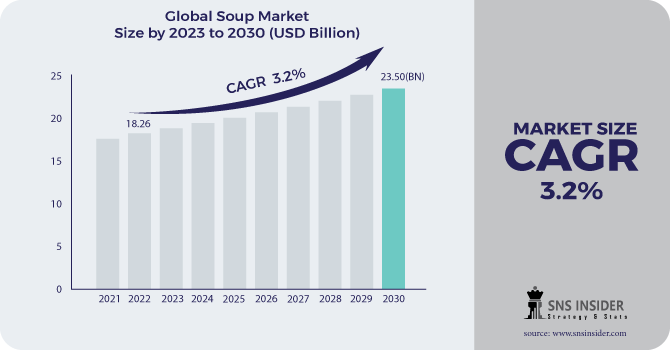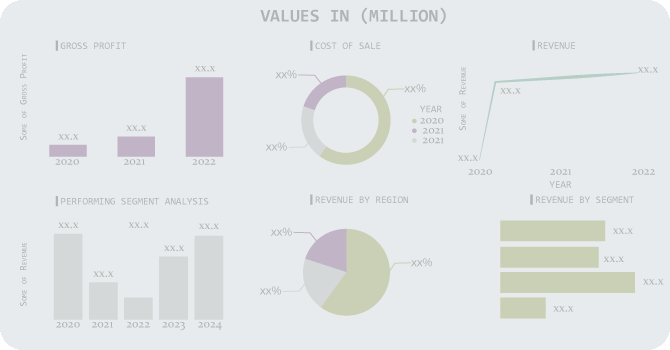Soup Market Report Scope & Overview:
Soup Market Size was valued at USD 18.26 billion in 2022, and is expected to reach USD 23.50 billion by 2030, and grow at a CAGR of 3.2% over the forecast period 2023-2030.
Soup is a fluid food which is served warm and viewed as the main course of a dinner and great canapés. Soup is arranged utilizing fixings like meat and vegetables with stock, juice, water and different fluids. It is additionally made by bubbling or stewing meat, fish, or vegetables with different added fixings and frequently containing strong pieces. Customarily soups are arranged into two primary gatherings' unmistakable soups and thick soups. Business soup became well known with the innovation of canning in nineteenth 100 years.

Soup is a scrumptious and nutritious feast which are high in vitamin A, B, K, C, cream soups are plentiful in vitamin D, and soups are low in fat settling on them a best decision for the people who favor a solid eating regimen as it has high extent of water in it. It is the least demanding method for adding vegetables to your everyday dinner. Eating hot/warm soup can assist with clearing the sinuses with steam.
Vegetable soups are low in calories and high in supplements, and helps your vegetable admission, while non veg soup help treating the actual illnesses, and helps in eliminating microscopic organisms in throat, mouth and tonsils.
Market Dynamics:
Driving Factors:
-
The expanded interest for accommodation food sources.
-
Developing attention to the medical advantages of soups.
Restraining Factor:
-
The canned food production network.
-
Severe guideline and item owed to the presence of hurtful substances.
Opportunities:
-
The presentation of new items with extra flavors and fixings that are well known among the youthful populace.
-
Bundling offers an expanded time span of usability to soup and doesn't respond with food material inside.
Challenges:
-
The rising inclination for flavors over fixings.
-
Recognition of the admission of intense usage of corn starch brings about high glucose level by diet-conscious consumer.
Impact of Covid-19:
Online retail shopping has impressively expanded in the beyond couple of years, particularly during the COVID-19 pandemic. It supported the interest for prepared to-eat soups and is helping the business development.
As soups are likewise viewed as invulnerability sponsors, they are seeing sound interest during the pandemic. Alarm purchasing because of the cross country lockdown in numerous nations likewise added to the market development.
Key Market Segmentation:
By Type:
-
Canned/Preserved Soup
-
Chilled Soup
-
Dehydrated Soup
-
Frozen Soup
-
UHT Soup
By Category:
-
Vegetarian Soup
-
Non-Vegetarian Soup
By Packaging:
-
Canned
-
Pouched
-
Others
By Distribution Channel:
-
Supermarkets and Hypermarkets
-
Convenience Stores
-
Online Stores
-
Others
.png)
In light of Product, the market is fragmented into Canned, Dried, UTH (Ultra-high Temperature Processing), and others. Canned soup can be consolidated, in which case it is ready by adding water (or once in a while milk), or it very well may be "prepared to-eat," in which case no additional fluid is expected before utilization.
In view of Distribution Channel, the market is divided into Supermarkets and Hypermarkets, Convenience Stores, and Online. The general stores and Hypermarkets fragment is supposed to hold the biggest piece of the pie.
By Packaging, the parcels section represented the most elevated share in the worldwide bundled soup market. The parcels fragment incorporates pocket and cup.
Regional Analysis:
-
North America
-
USA
-
Canada
-
Mexico
-
-
Europe
-
Germany
-
UK
-
France
-
Italy
-
Spain
-
The Netherlands
-
Rest of Europe
-
-
Asia-Pacific
-
Japan
-
south Korea
-
China
-
India
-
Australia
-
Rest of Asia-Pacific
-
-
The Middle East & Africa
-
Israel
-
UAE
-
South Africa
-
Rest of Middle East & Africa
-
-
Latin America
-
Brazil
-
Argentina
-
Rest of Latin America
-
Based on Geography, The Global Soup Market is ordered into North America, Europe, Asia Pacific, and the Rest of the world. Inferable from the accessibility of a bigger client base for canned soups in Europe, the locale is probably going to have the biggest portion of the market. In Europe, the U.K. also, Russia are driving shoppers of soup attributable to the always developing populace and handled food utilization in these areas is high.
Key Players:
Major company profiles included in soup market are Ajinomoto co., inc., B&g foods inc., Campbell soup company, Conagra brands, inc., General mills inc., Kettle cuisine, llc,, Nestle s. A., The hain celestial group, The kraft heinz company, Unilever plc.
Campbell soup company-Company Financial Analysis

| Report Attributes | Details |
|---|---|
| Market Size in 2022 | US$ 18.26 Billion |
| Market Size by 2030 | US$ 23.50 Billion |
| CAGR | CAGR 3.2% From 2023 to 2030 |
| Base Year | 2022 |
| Forecast Period | 2023-2030 |
| Historical Data | 2020-2021 |
| Report Scope & Coverage | Market Size, Segments Analysis, Competitive Landscape, Regional Analysis, DROC & SWOT Analysis, Forecast Outlook |
| Key Segments | • by Type (canned/preserved soup, chilled soup, dehydrated soup, frozen soup, UHT soup) • by distribution channel (supermarket/hypermarket, convenience stores, online retail store, other distribution) |
| Regional Analysis/Coverage | North America (USA, Canada, Mexico), Europe (Germany, UK, France, Italy, Spain, Netherlands, Rest of Europe), Asia-Pacific (Japan, South Korea, China, India, Australia, Rest of Asia-Pacific), The Middle East & Africa (Israel, UAE, South Africa, Rest of Middle East & Africa), Latin America (Brazil, Argentina, Rest of Latin America) |
| Company Profiles | Ajinomoto co., inc., B&g foods inc., Campbell soup company, Conagra brands, inc., General mills inc., Kettle cuisine, llc,, Nestle s. A., The hain celestial group, The kraft heinz company, Unilever plc. |
| Key Drivers | •The expanded interest for accommodation food sources. •Developing attention to the medical advantages of soups. |
| Restraints | •The canned food production network. •Severe guideline and item owed to the presence of hurtful substances. |

